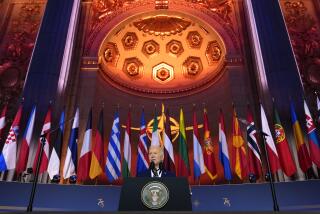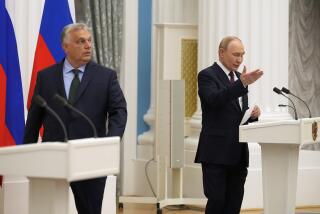Obama plans meetings with Baltic leaders, sending a message to Russia
President Obama will travel to Estonia next month, visiting the former Soviet republic as he seeks to reassure leaders in the region who worry that Russian aggression in Ukraine may spread.
Obama will hold bilateral meetings with Estonia’s President Toomas Hendrik Ilves and Prime Minister Taavi Roivas in Tallinn, the capital, the White House announced Friday. Obama will also attend a summit with Ilves and the two other Baltic presidents, Andris Berzins of Latvia and Dalia Grybauskaite of Lithuania.
The trip probably will get a chilly response from Moscow, where President Vladimir Putin takes a dim view of what he sees as U.S. meddling with countries that should belong to a Russian sphere of influence. A decade ago, Russian leaders were angered by a similar Baltic trip taken by then-President George W. Bush.
The stop in Estonia was tacked onto a previously scheduled trip to Europe. The president is to attend the North Atlantic Treaty Organization summit in Wales on Sept. 4.
News about the trip came on a day of escalating tension in the region, with Ukraine’s president saying that his country’s forces had destroyed “a significant part” of a Russian military convoy that crossed into Ukrainian territory during the night. The assertion was denied by Russia.
Tension had already been rising over a separate convoy dispatched from Moscow this week that the Kremlin said was carrying food, clothing and generators for civilians caught in the fighting between the Ukrainian government and pro-Russia separatists in the eastern Ukrainian city of Luhansk.
Ukraine suspects that the Kremlin plans to use the humanitarian convoy as cover for a military invasion to shore up the flagging separatist movement, and it has pledged to defend its territory from outside attack.
Ukrainian President Petro Poroshenko spoke with British Prime Minister David Cameron by telephone Friday about British news reports that armored Russian vehicles were seen crossing into Ukraine, near where more than 200 vehicles in the aid convoy were waiting for clearance to enter, according to a statement posted on the Ukrainian presidency’s website.
In Washington, National Security Council spokeswoman Caitlin Hayden said the U.S. is “working to gather more information” on the incident. But “we reiterate our concern about repeated Russian and Russian-supported incursions into Ukraine. Russia has no right to send vehicles, persons, or cargo of any kind into Ukraine, under any pretext, without the government of Ukraine’s permission.
“The escalation in Russian activity designed to destabilize Ukraine in recent weeks is extremely dangerous and provocative” she said.
Since Russia’s annexation of Crimea and support for separatists in Ukraine, Obama has repeatedly sought to reassure European leaders that the U.S. remains prepared to defend its NATO allies. The president carried a similar message in a visit to Poland in June.
Unlike Ukraine, the three Baltic nations are NATO members. The three were occupied by the Soviets after World War II and absorbed into the Soviet Union, but broke free of Moscow’s control when Soviet power crumbled in 1991.
The White House described the planned trip as an opportunity “to discuss ongoing cooperation on regional security and policies that support economic growth, and to discuss collective defense,” Hayden said.
“In light of recent developments in Ukraine, the United States has taken steps to reassure allies in Central and Eastern Europe, and this trip is a chance to reaffirm our ironclad commitment to Article V as the foundation of NATO,” she said.
Special correspondent Isabel Gorst in Moscow and Times staff writer Alexandra Zavis in Los Angeles contributed to this report.
For more news from the White House follow @khennessey on Twitter
More to Read
Sign up for Essential California
The most important California stories and recommendations in your inbox every morning.
You may occasionally receive promotional content from the Los Angeles Times.










